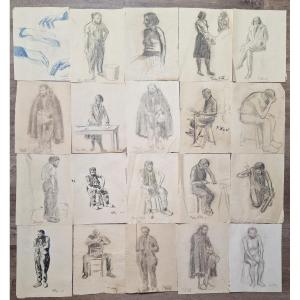Beautiful carving and patina of deep origin and quality. Delivery possible by chronopost for:
France €40
Europe €70
Others €100
Son of a former soldier, Michel Ney was born in Sarrelouis on January 10, 1769. A rider in the hussars since 1787, he distinguished himself during the Revolutionary Wars. Major general in 1799, he gained the confidence of the First Consul, who made him one of his first marshals (1804). In 1805, he led the 6th Hussar Corps to Germany and distinguished himself at the Elchingen Bridge. After Friedland in 1807, Napoleon I named him Duke of Elchingen. The one whom the emperor nicknamed the “Brave of the brave” then distinguished himself in Spain in 1808-1811, at the battle of Moskowa in Russia, in 1812, then at Krasnoye at the head of the rearguard. On November 28, at Bérézina, he crossed the Niemen last. Retired hero, he was made prince of Moscow. Doubt overtook him after the campaigns in Germany (1813) and France (1814). Made a peer of France by Louis XVIII, he joined Napoleon in 1815 and led the final cavalry charge at Waterloo. Arrested, he was condemned for treason and executed on December 7, 1815. Source: army museum ²Giuseppe Grandi was born in Ganne, not far from Varese, in a small village in northern Italy, on October 17, 1843. His father Francesco Grandi is a carpenter, while his mother, Marianna Cerutti, takes care of the couple's six boys. Giuseppe is the third of the siblings. At thirteen, he entered into an apprenticeship with a marble craftsman from Bisuschio where he stayed for a few years before enrolling at the Brera Academy. After a brief stay in Turin, he returned to Milan to continue his artistic studies at the Albertina Academy, with the Swiss-Italian sculptor Vincenzo Vela (1820-1891). He joined the Scapigliati, a group of young Milanese artists who advocated anti-academism in art, and research into the reflection of light. Giuseppe Growing up in this movement, develops living and vibrant modeling, free from any romanticism, and whose surfaces with their hollows and their roughness, catch and reflect the light. In 1866, Giuseppe Grandi achieved his first success, confirmed by numerous awards which followed one another. In 1871, he created for the Milan court a monumental statue of the great Milanese jurist of the Enlightenment Cesare Beccaria (1738-1749) which established his reputation. In 1881, he won the competition opened by the city of Milan to adorn the Piazza di Porta Vittoria with a monument which would celebrate the Cinque Giornate *. He worked there for fourteen years, but died on November 30, 1894, leaving it not quite finished...












































 Le Magazine de PROANTIC
Le Magazine de PROANTIC TRÉSORS Magazine
TRÉSORS Magazine Rivista Artiquariato
Rivista Artiquariato